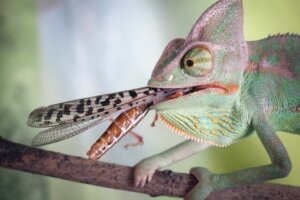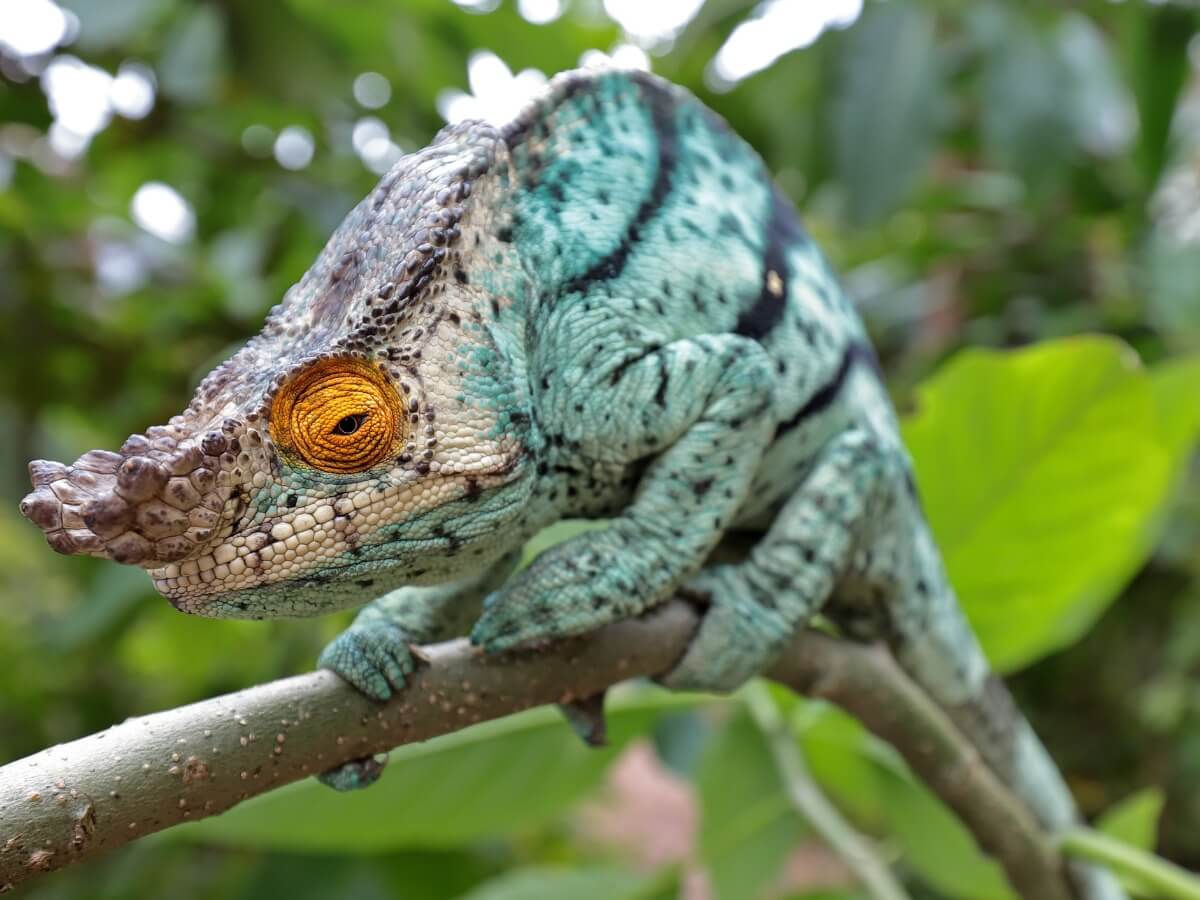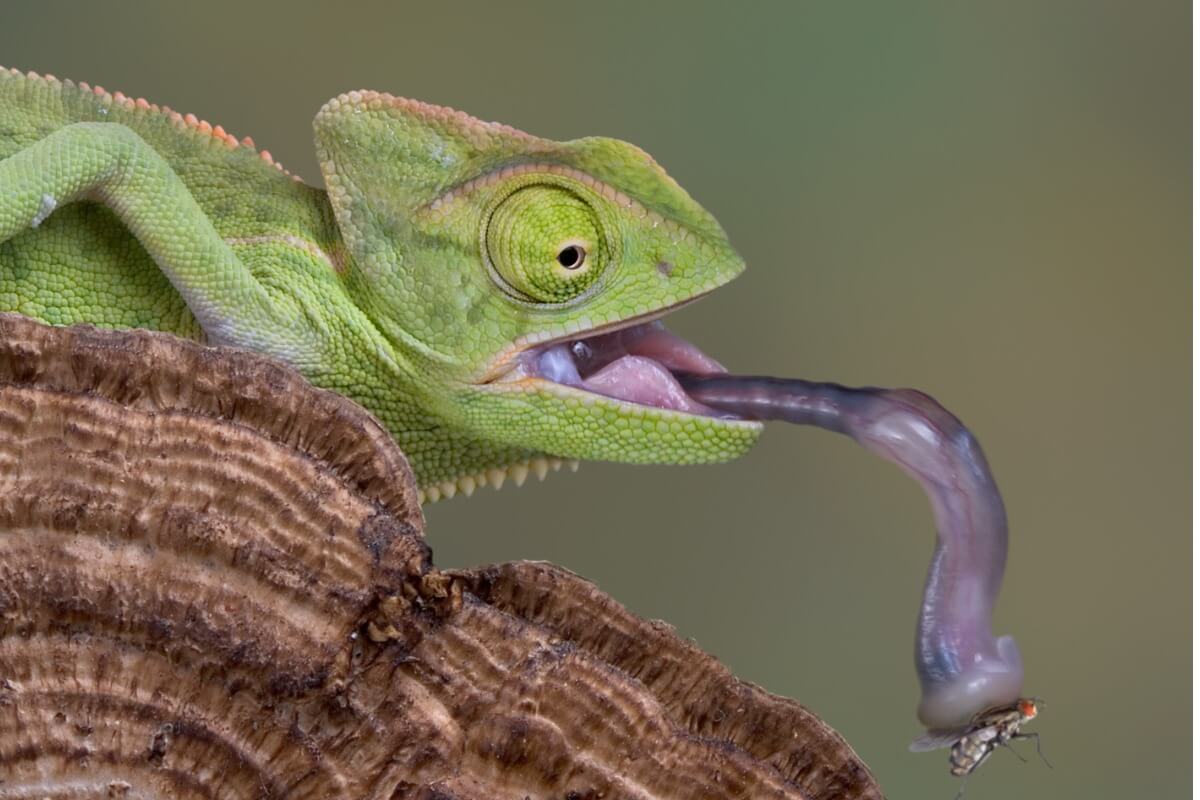What Do Chameleons Eat?


Written and verified by the biologist Samuel Sanchez
Chameleons are fascinating in every way, as they stand out for their slow pace, the ability to change color, the possession of independently mobile eyes, and how they hunt with their huge sticky tongue. When we look at this last attribute, it’s common for us to wonder what chameleons eat.
These reptiles keep many secrets as far as ethology is concerned and food is one of them, and you have to be very careful with this area if you keep chameleons in captivity. It isn’t uncommon for these animals to show signs of malnutrition and calcium deficiency, both of which are potentially lethal. Be sure to read this to find out more.
What are chameleons?
A chameleon is any vertebrate reptile that is included in the family Chamaeleonidae. This taxon contains more than 200 species, divided into 2 subfamilies (Brookesiinae and Chamaeleoninae) and 12 genera. Some of the most representative species in the domestic environment are the Yemen chameleon (Chamaeleo calyptratus) and the panther chameleon (Furcifer pardalis).
Chameleons have very different sizes. The species Brookesia micra doesn’t exceed 1.5 centimeters in body length, while Furcifer oustaleti reaches 65 centimeters without much difficulty. In any case, (almost) all these reptiles stand out for their cephalic crest, their sticky tongue, their zygodactyl (hooked) toes, and their eyes which are almost completely covered by eyelids.
Most of the species included in this group are diurnal and carry out most of their activity in the branches and trunks of trees. More and more types of chameleons are kept in captivity, but they’re considered pets only for experts. They’re quite vulnerable when it comes to humidity, feeding, and lighting.

What do chameleons eat?
Now you know a little more about these reptiles, we’re ready to dissect what chameleons eat. We will divide their dietary choices according to the environment they live in, as the menu of a wild specimen has little to do with that of a captive one. Don’t miss it!
What do chameleons eat in the wild?
All members of the family Chamaeleonidae are primarily insectivorous. This means that the bulk of their diet is made up of hexapod invertebrates, such as grasshoppers, moths, hymenopterans, beetles and crickets, among others. In addition, it has been recorded that species such as the Yemen chameleon have a predilection for green prey.
The most striking feature of these reptiles is their retractable tongue, which they project over considerable distances to catch their prey. This sticky organ is composed of hyoid bones, strong musculature, and collagen elements. This complexity gives the chameleon an estimated hunting speed of about 0.07 seconds.
Despite their predatory nature, many species have been recorded to feed very sporadically on certain leaves. However, they only adopt this behavior in the wild to quench their thirst during the hottest and driest months of the year. In addition, some larger specimens prey on small vertebrates, such as birds or developing mammals.
A chameleon’s tongue can be twice as long as its body when it’s extended (not counting the tail).
What do chameleons eat in captivity?
Providing chameleons with a varied diet is key to their proper development. Most species grow at a dizzying rate (they reach sexual maturity in less than 1 year and die in 3-5 years), so they need a constant nutritional intake to avoid starvation or lack of calcium in their bones.
The basis of the diet can be Dubia cockroaches (Blaptica dubia), Shellfordella tartara, crickets (Acheta domesticus), and worms of the genera Tenebrio, Zophobas, and Galleria. It’s recommended to feed a wide variety of vegetables and proteins to these insects before offering them to the chameleon, as, in this way, they’ll obtain these nutrients indirectly.
In addition to the above, it’s essential to remember that every chameleon needs a calcium and vitamin supplement every few days (from every day to once a week, depending on the species). Sprinkle the live prey with specific products as indicated by the professional who sold you the animal.
Chameleons only eat live insects, as they rely on the movement of their prey to hunt.
Feeding the baby chameleon
Due to their rapid growth rate, juvenile chameleons need to eat as much as they want every day. However, prey should be offered according to the size and weight of the animal so that it doesn’t hurt itself when trying to ingest it (it’s better if it’s half the diameter of its mouth or less in size).
At this stage, it’s especially important to use the right lighting and provide the right vitamins. Otherwise, the animal won’t develop well.
Feeding the adult chameleon
When the specimen reaches a suitable weight and length, the number of invertebrates offered should be reduced considerably. It’s generally recommended to feed 2-3 medium-sized prey every other day or, failing that, 1 insect per day (a large cricket or a sub-adult cockroach, for example). Be very careful not to make the animal obese.
At this time, some keepers try to include green sprouts and other vegetables in the chameleon’s diet to give it an extra supply of water. Some chameleons will eat them without any problems, while others will show no interest at all. However, you should make sure that the animal can drink water as it would in the wild.
Feeding pregnant females
Most females of almost any chameleon species lay eggs every 3-6 months even if they aren’t fertilized. Naturally, no offspring hatch from them, but it’s a very demanding process for the mother and requires some help with feeding. Therefore, a pregnant female can eat as much as she needs until she lays her eggs.
An exception to this rule are the females of the Yemen chameleon (Chamaeleo calyptratus), as they grow at an extremely fast rate and are ready to lay eggs in some cases at 6 months of age. It’s very important not to overfeed them at this time, as they could have complications when trying to release the clutch, and could die as a result.
If you have a female, consult a vet about her diet. Remember that she’ll lay eggs even if she hasn’t been fertilised.

As you can see, answering the question of what chameleons eat is much more complex than it might seem at first. These reptiles are eminently insectivorous, but the frequency of hunting depends a lot on the age, species, and sex of each individual.
All cited sources were thoroughly reviewed by our team to ensure their quality, reliability, currency, and validity. The bibliography of this article was considered reliable and of academic or scientific accuracy.
- Chamaeleo calyptratus, ADW. Recogido a 18 de octubre en https://animaldiversity.org/accounts/Chamaeleo_calyptratus/
- Chameleon Care Guide, Pet Smart. Recogido a 18 de octubre en https://www.petsmart.com/learning-center/reptile-care/chameleon-care-guide/A0316.html
- Basics: Feeding Chameleons, Chameleon Academy. Recogido a 18 de octubre en https://chameleonacademy.com/basics-feeding-chameleons/
This text is provided for informational purposes only and does not replace consultation with a professional. If in doubt, consult your specialist.